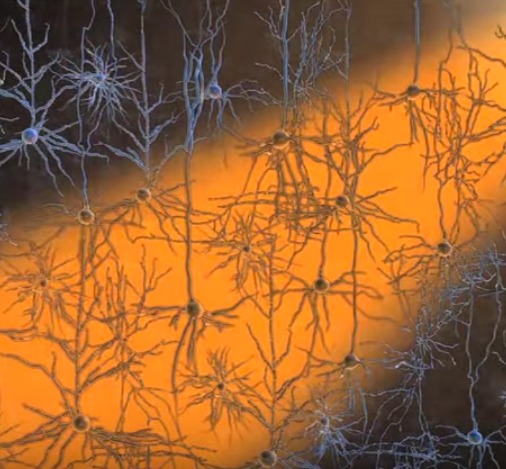Blocking pain by turning off specific neurons with light
April 22, 2016

Optogenetic inhibition of neurons (credit: McGovern Institute for Brain Research/MIT)
McGill University researchers have discovered an effective alternative to pain medication (such as the opiate percocet that Prince was reportedly taking): optogenetics — using light to control cells (such as neurons) in living tissue.
The scientists bred mice that were genetically engineered, causing specific peripheral neurons responsible for pain transmission to express an opsin (light-sensitive protein). (See Optogenetics switch turns neurons on and off and Controlling pain by optogenetic stimulation of the brain’s pain center.)
Shining yellow light on skin above those modified Nav 1.8+ nociceptor neurons (in the hind paw) caused them to shut off, decreasing the mouse’s sensitivity to pain (from touch and heat).* The duration of the effect could be controlled by the amount of time the light was applied.
Hope for pain relief in humans
Further advances in neuroscience are necessary to apply this method of pain relief to humans, according to professor Philippe Séguéla, a researcher at the Montreal Neurological Institute and Hospital and the article’s senior author. Séguéla says one possible way to make human neurons photosensitive would be through the use of a harmless virus that could be injected, as needed, to temporarily deliver opsins to specific neurons, without causing side effects.
Opiates are the most commonly used treatment for chronic pain today, but they are often used systemically and not directed to the specific region of the body affected by the pain. The duration of the opiate effects can also not be accurate estimated, compared to the precision with a beam of light.
It is estimated that between 26.4 million and 36 million people abuse opioids worldwide, with an estimated 2.1 million people in the U.S. suffering from substance-use disorders related to prescription opioid pain relievers in 2012 and an estimated 467,000 addicted to heroin, according to the NIH National Institute on Drug Abuse.
The research, published in an open-access paper in the journal eNeuro, was funded by the Canadian Institutes of Health Research, the Natural Sciences and Engineering Research Council, the Quebec Pain Research Network, and the Louise and Alan Edwards Foundation.
* Q: What is the maximum transdermal penetration depth for yellow light, and based on that, which types of peripheral neurons could potentially be treated effectively without light-induced trauma?
A: We don’t have an accurate measurement of the depth of light penetration in the skin, however, we can say that yellow light reaches the different layers of the epidermis and likely the superficial part of the dermis. Light intensity decreases exponentially as it enter the skin, but at the light intensities we used, it should be sufficient to reach the terminals of various sensory neurons. Sensory neurons (except proprioceptors) innervate the skin, and their endings terminate in the dermis/epidermis of the skin. Therefore, transdermal illumination can be efficient to modulate the activity of most of these sensory fibers. The parameters of our optical stimulations (light intensity, duration of light application) are innocuous and non-invasive, hence they don’t cause any trauma. — Ihab Daou, lead author, Department of Neurology and Neurosurgery, Montreal Neurological Institute
UPDATE 4/25/2016 Added Q&A on yellow-light penetration
Abstract of Optogenetic silencing of Nav1.8-positive afferents alleviates inflammatory and neuropathic pain
We report a novel transgenic mouse model in which the terminals of peripheral nociceptors can be silenced optogenetically with high spatio-temporal precision, leading to the alleviation of inflammatory and neuropathic pain. Inhibitory archaerhodopsin-3 (Arch) proton pumps were delivered to Nav1.8+ primary afferents using the Nav1.8-Cre driver line. Arch expression covered both peptidergic and non-peptidergic nociceptors and yellow light stimulation reliably blocked electrically-induced action potentials in DRG neurons. Acute transdermal illumination of the hind paw of Nav1.8-Arch+ mice significantly reduced mechanical allodynia under inflammatory conditions, while basal mechanical sensitivity was not affected by the optical stimulation. Arch-driven hyperpolarization of nociceptive terminals was sufficient to prevent ChR2-mediated mechanical and thermal hypersensitivity in double transgenic Nav1.8-ChR2+-Arch+ mice. Furthermore, prolonged optical silencing of peripheral afferents in anesthetized Nav1.8-Arch+ mice led to post-stimulation analgesia with a significant decrease in mechanical and thermal hypersensitivity under inflammatory and neuropathic conditions. These findings highlight the role of peripheral neuronal inputs in the onset and maintenance of pain hypersensitivity, demonstrate the plasticity of pain pathways even after sensitization has occurred, and support the involvement of Nav1.8+ afferents in both inflammatory and neuropathic pain. Taken together, we present a selective analgesic approach in which genetically-identified subsets of peripheral sensory fibers can be remotely and optically inhibited with high temporal resolution, overcoming the compensatory limitations of genetic ablations.
Significance Statement: Selective activation and/or inhibition of peripheral nociceptors allow us to control pain transmission and modulate pain perception. Here, we generated a novel transgenic mouse line in which optical activation of archaerhodopsin-3 (Arch) proton pumps efficiently silenced the activity of Nav1.8+ nociceptive afferents. Acute and prolonged transdermal illumination of the hind paws of Nav1.8-Arch+ mice reduced mechanical and thermal hypersensitivity under inflammatory and neuropathic conditions, underlining the contribution of the peripheral neuronal component, particularly Nav1.8+ fibers, in the transmission of evoked pain as well as the development and maintenance of chronic pain. This optogenetic approach can be applied to functionally investigate other subsets of sensory neurons with high temporal precision, and safe genetic delivery of inhibitory opsins may prove useful for clinical applications.
